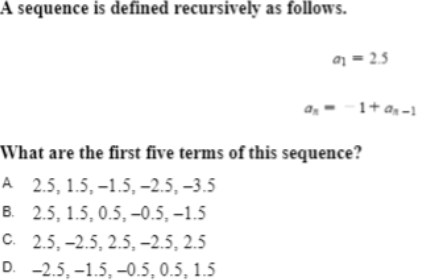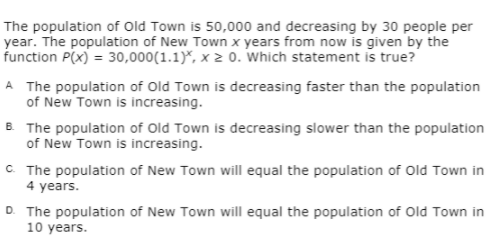A sequence is defined recursively as follows. a = 2.5 as 1+ a -1 What are the first five terms of this sequence? А 2.5, 1.5, -1.5, -2.5, -3.5 в. 2.5, 1.5, 0.5,-0.5, -1.5 C. 2.5, -2.5, 2.5, –2.5, 2.5 D. -2.5, -1.5, –0.5, 0.5, 1.5
A sequence is defined recursively as follows. a = 2.5 as 1+ a -1 What are the first five terms of this sequence? А 2.5, 1.5, -1.5, -2.5, -3.5 в. 2.5, 1.5, 0.5,-0.5, -1.5 C. 2.5, -2.5, 2.5, –2.5, 2.5 D. -2.5, -1.5, –0.5, 0.5, 1.5
Glencoe Algebra 1, Student Edition, 9780079039897, 0079039898, 2018
18th Edition
ISBN:9780079039897
Author:Carter
Publisher:Carter
Chapter7: Exponents And Exponential Functions
Section7.8: Transforming Exponential Expressions
Problem 13PFA
Related questions
Topic Video
Question

Transcribed Image Text:A sequence is defined recursively as follows.
a = 2.5
as
1+ a -1
What are the first five terms of this sequence?
А 2.5, 1.5, -1.5, -2.5, -3.5
в. 2.5, 1.5, 0.5,-0.5, -1.5
C. 2.5, -2.5, 2.5, –2.5, 2.5
D. -2.5, -1.5, –0.5, 0.5, 1.5

Transcribed Image Text:The population of Old Town is 50,000 and decreasing by 30 people per
year. The population of New Town x years from now is given by the
function P(x) = 30,000(1.1)*, x 2 o. Which statement is true?
A The population of Old Town is decreasing faster than the population
of New Town is increasing.
B. The population of Old Town is decreasing slower than the population
of New Town is increasing.
C The population of New Town will equal the population of Old Town in
4 years.
D. The population of New Town will equal the population of Old Town in
10 years.
Expert Solution
This question has been solved!
Explore an expertly crafted, step-by-step solution for a thorough understanding of key concepts.
This is a popular solution!
Trending now
This is a popular solution!
Step by step
Solved in 2 steps with 2 images

Knowledge Booster
Learn more about
Need a deep-dive on the concept behind this application? Look no further. Learn more about this topic, algebra and related others by exploring similar questions and additional content below.Recommended textbooks for you

Glencoe Algebra 1, Student Edition, 9780079039897…
Algebra
ISBN:
9780079039897
Author:
Carter
Publisher:
McGraw Hill

College Algebra
Algebra
ISBN:
9781305115545
Author:
James Stewart, Lothar Redlin, Saleem Watson
Publisher:
Cengage Learning


Glencoe Algebra 1, Student Edition, 9780079039897…
Algebra
ISBN:
9780079039897
Author:
Carter
Publisher:
McGraw Hill

College Algebra
Algebra
ISBN:
9781305115545
Author:
James Stewart, Lothar Redlin, Saleem Watson
Publisher:
Cengage Learning


Trigonometry (MindTap Course List)
Trigonometry
ISBN:
9781337278461
Author:
Ron Larson
Publisher:
Cengage Learning

Functions and Change: A Modeling Approach to Coll…
Algebra
ISBN:
9781337111348
Author:
Bruce Crauder, Benny Evans, Alan Noell
Publisher:
Cengage Learning

Algebra & Trigonometry with Analytic Geometry
Algebra
ISBN:
9781133382119
Author:
Swokowski
Publisher:
Cengage